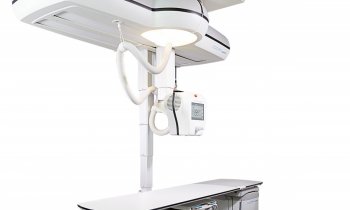News • Improved image quality, reduced radiation dose
Benefits of deep learning reconstruction in paediatric imaging
Recent developments in deep learning techniques are enhancing clinical imaging quality and reducing radiation exposure for patients while also maintaining diagnostic accuracy. The latest AI (artificial intelligence) component to clinical imaging – referred to as deep learning reconstruction (DLR) – is having a particular benefit in paediatric imaging, according to Dr Samuel Brady from Cincinnati Children’s Hospital Medical Center, US.
Report: Mark Nicholls

Speaking to an online audience during a series of webinars hosted by Canon Medical Systems Europe, providing in-depth insights into aspects of paediatric imaging, his presentation specifically focused on the impact of AI on CT image quality and dose.
Brady discussed advantages and limitations of FBP (filtered back projection) and IR (iterative reconstruction) algorithms for CT image reconstruction. He noted that while IR is good at removing spurious image noise and helps see body structures/organs clearer, it can soften structural and organ boundaries, leading to an image that may appear slightly blurry to the eye. However, DLR has demonstrated the ability to remove image noise while maintaining and sharp image and providing the ‘potential to further reduce radiation dose to patients undergoing CT,’ said Brady. As a result, the technique is increasingly preferred within paediatric imaging as it enables lower radiation dose, thus reducing risks for children where tissues are still developing and are more susceptible to radiation damage.
Increasing diagnostic confidence
In his presentation, the expert noted how CT reconstruction has undergone substantial changes, particularly with the ability of DLR to improve image quality and offer low-contrast detectability. Brady, who is Chief of the Clinical Medical Physics Section in the Medical Center’s Department of Radiology, said AI for CT reconstruction enables cleaner, noise reduced and sharper images with a stronger edge definition than current IR algorithms. ‘These improved images have been shown to increase diagnostic confidence for radiologist performance: they are able to see smaller, more subtle, structures with greater confidence – even at the lower radiation dose levels afforded by DLR,’ he added.
The reduction of image noise – the statistical fluctuation in the reconstruction algorithm that overlays the image and can obscure the underlying anatomy – has been a major benefit, the expert pointed out. ‘For the last 15 years, IR algorithms have reduced image noise in CT images, but at the cost of softening organ boundaries, giving the image a blurry, soft, and sometimes plastic look. That interferes with radiologist’s ability to identify low-contrast objects, such as cancer or infections, in the image. DLR now removes the image noise while keeping object edges sharp.’
The ability to see small objects sharper and more conspicuous is a huge win for paediatric imaging, since children have smaller internal organs, vasculature, and other structures
Samuel Brady
Historically, the only way to remove image noise in a CT image was to increase patient radiation exposure. But with DLR trained to differentiate between noise and anatomical structure, image noise can be removed without turning up the radiation dose, said Brady.
He pointed to Canon’s proprietary DLR algorithm called “Advanced Intelligent Clear-IQ Engine (AiCE)” on CT platforms as advancing the field and particularly the new version of DLR, called “Precise IQ Engine (PIQE)”, which is designed to further increase object-edge sharpness. ‘The ability to see small objects sharper and more conspicuous is a huge win for paediatric imaging, since children have smaller internal organs, vasculature, and other structures,’ said Brady. ‘I believe PIQE is going to take paediatric CT imaging to a new level of clarity.’
He said DLR is making a difference to care by enabling low noise and low dose imaging in CT. For IR, the consensus was that dose reduction should be limited to 15-30% to preserve low-contrast detectability. But Brady pointed out that initial phantom and patient observer studies in DLR have shown acceptable dose reduction between 44-83% for both low- and high-contrast object detectability tasks.
Ultrasound for abdominal emergencies
A second element of the Canon webinar saw paediatric radiologist Dr Elisa Aguirre from Hospital 12 de Octubre in Madrid, Spain, outline how abdominal symptoms are the most common reason for paediatric emergency department visits, with ultrasonography usually the first line and main technique in enabling the diagnosis. During her presentation, she explained how Doppler ultrasound and microvascular imaging can add relevant information in paediatric abdominal emergencies. Aguirre is actively involved in ultrasound departmental and interdepartmental working groups and clinical commissions.
Profile:
Dr Samuel Brady is Chief of the Clinical Medical Physics Section in the Department of Radiology, Cincinnati Children’s Hospital Medical Center and Associate Professor of Radiology, University of Cincinnati. As a medical physicist, his primary experience lies in developing and maintaining protocols for imaging efficacy and safety with a particular interest in dose-minimization for CT imaging techniques.
31.10.2024











